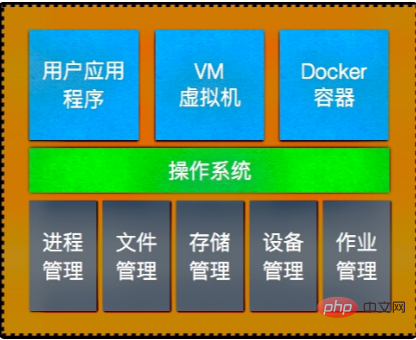What are the five major functions of the operating system?
The five major functions of the operating system: 1. Processor management; 2. Memory management; 3. Device management; 4. File management; 5. Job management, each user requests an independent operation completed by the computer system It's called a job.

#The operating environment of this article: Windows 7 system, Dell G3 computer.
Five major functions of the operating system:
1. Processor management
The most basic function of processor management is to handle interrupt events and configure operations Once the system is installed, various events can be processed. Another function of processor management is processor scheduling, which adopts different scheduling strategies for different situations.
2. Memory management
Memory management mainly refers to the management of internal memory. The main task is to allocate memory space to ensure that there is no conflict in the storage space occupied by each job, and to prevent each job from interfering with each other in its own storage area.
3. Device management
Device management refers to the management of various peripheral devices, including allocation, startup and fault handling. The main task is that when the user uses an external device, he or she must make a request, and it can only be used after the operating system has uniformly allocated it.
4. File management
File management refers to the management of information resources by the operating system. In an operating system, the part responsible for accessing management information is called a file system. File management supports file storage, retrieval and modification operations as well as file protection functions.
5. Job management
An independent operation that each user requests the computer system to complete is called a job. Job management includes job input and output, job scheduling and control, which controls job running according to user needs.

Extended information:
1. Classification of operating systems:
(1) According to the working method, it is divided into: batch operating system , time-sharing operating system, real-time operating system, network operating system and distributed operating system, etc.;
(2) According to the architecture, it can be divided into: single-core operating system, multi-core operating system, etc.;
(3) According to the running environment, it can be divided into: desktop operating system, embedded operating system, etc.;
(4) According to the length of the instruction, it can be divided into: 8bit, 16bit, 32bit, 64bit operating system.
2. The operating system is a computer program that manages computer hardware and software resources. It is also the core and cornerstone of the computer system. The operating system needs to handle basic tasks such as managing and configuring memory, prioritizing the supply and demand of system resources, controlling input and output devices, operating networks, and managing file systems. The operating system also provides an operating interface for users to interact with the system.
If you want to learn more about programming, please pay attention to the php training column!
The above is the detailed content of What are the five major functions of the operating system?. For more information, please follow other related articles on the PHP Chinese website!

Hot AI Tools

Undresser.AI Undress
AI-powered app for creating realistic nude photos

AI Clothes Remover
Online AI tool for removing clothes from photos.

Undress AI Tool
Undress images for free

Clothoff.io
AI clothes remover

Video Face Swap
Swap faces in any video effortlessly with our completely free AI face swap tool!

Hot Article

Hot Tools

Notepad++7.3.1
Easy-to-use and free code editor

SublimeText3 Chinese version
Chinese version, very easy to use

Zend Studio 13.0.1
Powerful PHP integrated development environment

Dreamweaver CS6
Visual web development tools

SublimeText3 Mac version
God-level code editing software (SublimeText3)

Hot Topics
 Centos install mysql
Apr 14, 2025 pm 08:09 PM
Centos install mysql
Apr 14, 2025 pm 08:09 PM
Installing MySQL on CentOS involves the following steps: Adding the appropriate MySQL yum source. Execute the yum install mysql-server command to install the MySQL server. Use the mysql_secure_installation command to make security settings, such as setting the root user password. Customize the MySQL configuration file as needed. Tune MySQL parameters and optimize databases for performance.
 vscode cannot install extension
Apr 15, 2025 pm 07:18 PM
vscode cannot install extension
Apr 15, 2025 pm 07:18 PM
The reasons for the installation of VS Code extensions may be: network instability, insufficient permissions, system compatibility issues, VS Code version is too old, antivirus software or firewall interference. By checking network connections, permissions, log files, updating VS Code, disabling security software, and restarting VS Code or computers, you can gradually troubleshoot and resolve issues.
 Is the vscode extension malicious?
Apr 15, 2025 pm 07:57 PM
Is the vscode extension malicious?
Apr 15, 2025 pm 07:57 PM
VS Code extensions pose malicious risks, such as hiding malicious code, exploiting vulnerabilities, and masturbating as legitimate extensions. Methods to identify malicious extensions include: checking publishers, reading comments, checking code, and installing with caution. Security measures also include: security awareness, good habits, regular updates and antivirus software.
 How to run programs in terminal vscode
Apr 15, 2025 pm 06:42 PM
How to run programs in terminal vscode
Apr 15, 2025 pm 06:42 PM
In VS Code, you can run the program in the terminal through the following steps: Prepare the code and open the integrated terminal to ensure that the code directory is consistent with the terminal working directory. Select the run command according to the programming language (such as Python's python your_file_name.py) to check whether it runs successfully and resolve errors. Use the debugger to improve debugging efficiency.
 What is the main purpose of Linux?
Apr 16, 2025 am 12:19 AM
What is the main purpose of Linux?
Apr 16, 2025 am 12:19 AM
The main uses of Linux include: 1. Server operating system, 2. Embedded system, 3. Desktop operating system, 4. Development and testing environment. Linux excels in these areas, providing stability, security and efficient development tools.
 How to choose the PyTorch version on CentOS
Apr 14, 2025 pm 06:51 PM
How to choose the PyTorch version on CentOS
Apr 14, 2025 pm 06:51 PM
When installing PyTorch on CentOS system, you need to carefully select the appropriate version and consider the following key factors: 1. System environment compatibility: Operating system: It is recommended to use CentOS7 or higher. CUDA and cuDNN:PyTorch version and CUDA version are closely related. For example, PyTorch1.9.0 requires CUDA11.1, while PyTorch2.0.1 requires CUDA11.3. The cuDNN version must also match the CUDA version. Before selecting the PyTorch version, be sure to confirm that compatible CUDA and cuDNN versions have been installed. Python version: PyTorch official branch
 Can vscode run in Windows 7
Apr 15, 2025 pm 07:27 PM
Can vscode run in Windows 7
Apr 15, 2025 pm 07:27 PM
VS Code is still available on Windows 7, but is highly not recommended. Windows 7 lacks security updates and patches, resulting in security risks and VS Code compatibility issues. Although simple code editing is barely competent, it is recommended to upgrade to Windows 10 or later for complex development or for extensions.
 git software installation
Apr 17, 2025 am 11:57 AM
git software installation
Apr 17, 2025 am 11:57 AM
Installing Git software includes the following steps: Download the installation package and run the installation package to verify the installation configuration Git installation Git Bash (Windows only)





